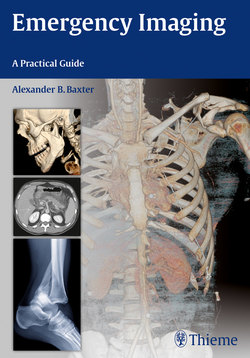Читать книгу Emergency Imaging - Alexander B. Baxter - Страница 39
На сайте Литреса книга снята с продажи.
Оглавление25
2Brain
ity of the brain to tamponade low-pressure hemorrhages. In such patients, enlarged extracerebral space limits the degree of pa-renchymal compression and ischemia.
Acute SDHs are crescentic, hyperdense, and usually homogeneous. They can ex-tend along the entire hemisphere and are confined by the falcine and tentorial dural reflections. In contrast to most EDHs, SDH is not limited by calvarial sutures. Venous hemorrhage is usually more gradual than arterial bleeding, and SDHs can develop more slowly than EDHs. Nonetheless, large SDHs can cause acute and severe neurolog-ic deterioration and often require urgent evacuation. Hematoma thickness or sub-falcine shift of 2 cm or greater is associated with a particularly poor prognosis.
The density of subdural clot can overlap with that of calvarial bone on narrow CT windows optimized for evaluation of brain parenchyma, and small subdural hemato-mas can be dicult to detect. To avoid this error, head CT obtained for trauma should always be viewed at both narrow and wide (subdural) window settings (Fig. 2.7).
◆Acute Subdural Hematoma
Acute subdural hematomas (SDHs) occurwhen cortical veins that traverse the subdu-ral space are torn under cerebral accelerationor rotation. Blood accumulates between theinner (meningeal) layer of the dura, which isfirmly attached to the skull, and the smooth arachnoid membrane loosely adherent tothe surface of the brain. Uncommonly, a pri-mary parenchymal or subarachnoid hemor-rhage can disrupt the arachnoid membraneand rupture into the subdural space. SDH isassociated with a skull fracture in less than50% of cases and is typically a “contrecoup”injury that results from recoil of the brainaway from the inner surface of the skull op-posite the site of impact.
Especially in younger patients, an acute SDH indicates significant energy transfer and is frequently associated with severe parenchymal brain injury, brain hernia-tion, and cerebral ischemia. SDH due to minor trauma is more common in the el-derly and in patients with cerebral atrophy. Parenchymal volume loss and enlarged CSF spaces allow the brain to move more freely in the calvarium and compromise the abil-
Fig. 2.7a–fa,b Acute subdural hematoma. 1.8-cm hyperdense left holohemispheric subdural hematoma with trau-matic subarachnoid hemorrhage, 1.6-cm subfalcine shift, compression of the left lateral ventricle, and trapping of the right lateral ventricle.
c,d Large right subdural hematoma with prominent frontal, parafalcine, and tentorial hyperdense collections.
e,f Window and level in detecting subdural hematoma. (e) CT window = 80 (brain) shows subtle ef-facement of right frontal sulci, but otherwise apparently normal brain. (f) CT window = 170 (subdural). A 5-mm right frontotemporal subdural hematoma is now clearly evident.
